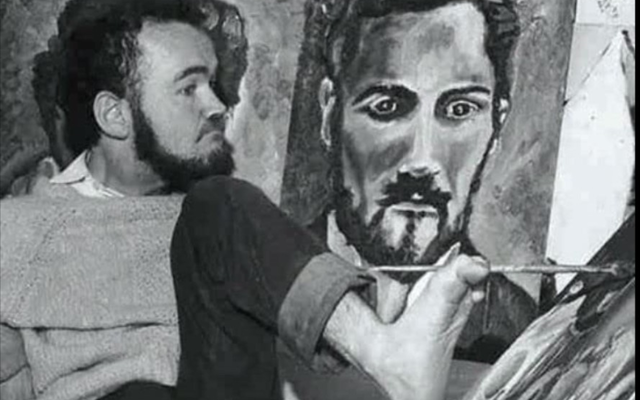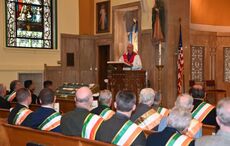Christy Brown, the Irish artist and writer best remembered through the Oscar-winning portrayal in "My Left Foot", died on September 7, 1981. Although born on June 5, 1932, in Dublin, it’s his courage, creativity, and the poignant struggles of his later years that resonate most deeply today. Operating only with the toes of his left foot, Brown crafted hundreds of paintings, four novels, four poetry collections, and his critically acclaimed memoir, all while confronting the isolating reality of cerebral palsy.
Irish artist and writer Christy Brown, who was born in Dublin on June 5, 1932 and died on September 7, 1981, is remembered by many people as the character played by Daniel Day-Lewis in the Oscar-winning film "My Left Foot."
But Christy Brown, the writer, and painter deserves closer inspection than a film can allow. The complexities of his life, together with his struggle to be understood – and taken seriously – have only recently come to light, although they underpin everything he created.
Christy Brown was born with cerebral palsy. The condition was isolating but it also informed his determination to become a singular chronicler of the human spirit. He produced hundreds of paintings in addition to writing over a thousand letters, a classic memoir, four novels and four books of poetry – all with the toes of his left foot, the only limb he had muscular control over. So how did he manage to achieve all this?
How Christy Brown started creating art
Christy Brown was born on June 5, 1932, after a three-day labor in Dublin’s Rotunda Hospital. He was the twelfth of 22 children born to Bridget and Patrick Brown, of which 13 survived. The Browns lived in a small terraced house.
Christy’s father was a bricklayer and many of his sons followed him into that profession. When asked by a journalist if he ever wondered what his life would have been like without his “terrible handicap”, Christy laughed and said, “I know. I would have been a good bricklayer like my father.”
Christy’s mother struggled to get a diagnosis of Christy’s condition. It was later determined that Christy was a ‘mental defective’ who should be placed in an institution. Parts of his brain were damaged due to a lack of oxygen at birth but, although physically impaired, his mind functioned perfectly. Bridget insisted he would not be sent away. Her daughter Anne said later that Bridget “always knew there was something there; she saw that light in his eyes. And she brought out that brightness, that spark.”
At the age of five, Christy snatched a piece of chalk from his sister with his left foot and began writing with it. Christy never had any formal education, but with support from his mother, he gradually learned to write and communicate. Bridget also provided primary care for Christy, whilst bringing up twelve other children and struggling to make ends meet. (When actress Brenda Fricker won an Oscar for playing Bridget Brown, she said, “Any woman who gives birth to twenty-two children deserves one of these.” Christy would have agreed. He dedicated the book on which the film is based to Bridget.)
As a child, Christy went on mischievous escapades with his brothers and sisters in his ‘chariot’, a go-kart called Henry. They gave him a cigarette – which he ate whole – and used Henry to hide stolen fruit when the police came by. A few years later, Christy learned to use a paintbrush between his toes.
Katriona Maguire (née Delahunt) was training to be a social worker at the Rotunda Hospital when she met Bridget, who was recuperating after the birth of her thirteenth child. Katriona was fascinated by Bridget’s stories of Christy and went to visit the boy who painted with his toes. Christy fell in love with Katriona. It was with her encouragement and financial assistance that he took his first trip abroad, to Lourdes, in 1948. Katriona would give support to Christy throughout his life; their letters to each other are a poignant record of a long and remarkable friendship.
How Christy Brown started to write
At the age of 18, Christy decided to write his life story. It took him four years to complete. After surrendering the use of his left foot, he had to rely on a scribe. His brothers and sisters reluctantly did the brunt of this work. Christy’s sister Ann recalls receiving a kick from his left foot whenever she spelled a word wrong.
After writing 400 pages of "The Reminisces of a Mental Defective." Christy asked Dr. Bob Collis for help, unaware that he was a published writer himself. After trawling through the long-winded manuscript, Collis discovered a sentence that he described as “a rose among a lot of weeds.” Collis agreed to assist but demanded that Christy first read someone more modern than Charles Dickens.
Collis and Katriona Maguire arranged for Christy to receive some basic education through the local church. He also started speech therapy with Dr. Patricia Sheehan, which improved his ability to communicate with people outside his family. Christy finally completed his memoir at the age of 22, but not before evicting his brother Francis from the study, tearing off his shoe and sock, and writing the whole thing with his left foot.

Love Irish history? Share your favorite stories with other history buffs in the IrishCentral History Facebook group.
Christy Brown and "My Left Foot"
"My Left Foot" was published in 1954. Christy would soon become internationally recognized as a writer of great distinction, although he came to regret My Left Foot and the fact that he would be remembered by the world for the ‘miracle story', rather than for more serious work.
In 1956, he decided to end his physiotherapy so that he could spend more time writing, but he also turned to drinking – much of the time in a pub in Kimmage with family and friends. He would increasingly come to rely on drink, both to write and to reconcile himself to the world.
Christy acknowledged that he would never have the same talent for art as he did for writing, but he painted throughout his life. He was one of the first members of Arnulf Stegmann’s Disabled Artists Association, which paid Christy a monthly sum in return for producing a number of paintings each year. He was frustrated about the time this took from his writing, but he produced hundreds of paintings that portray his struggles, epiphanies, and feelings of isolation as keenly as his literature, particularly as he grew older.
Bridget Brown died in September 1968. Distraught, Christy buried himself in work and completed his novel "Down All The Days" in 1969. The mother of the central character is heroic, but the novel explores disturbing themes of domestic abuse, poverty, alcoholism, and death – perceived through the watchful eyes of the unnamed central character, silent and crippled. Christy’s masterpiece is unstinting in its depiction of working-class Dublin life while making perceptive observations about the human spirit. Shocking, indeed ground-breaking, this remarkable novel was the subject of lavish praise in the literary world.
To promote the book, Christy appeared on the David Frost Show in New York in 1970. Asked what he would do now that he was a famous author, Christy gurgled his drink and said he would buy a pub. Later in the interview, he advised viewers of the show simply to “love life.”
Women played a key role throughout Christy’s life. He dedicated his first collection of poetry "Come Softly To My Wake" (1971) to his sister Ann, for “helping to keep the ship afloat.” His relationship with a married American called Beth Moore helped him maintain some stability whilst writing "Down All The Days", and the book is dedicated to her “who, with such gentle ferocity, finally whipped me into finishing this book.”
Beth wrote to Christy in 1954 after reading an excerpt of "My Left Foot" in Good Housekeeping, and their relationship developed when Christy first traveled to the United States in 1960. Beth, her husband, and Christy were together in Ireland and America several times, but the affair was strained by the distance and nature of the relationship. Christy severed all ties in 1972 before marrying Mary Carr, a decision that shocked many of those closest to him.
The Christy Brown ending the film "My Left Foot" does not include
In the film "My Left Foot," Mary is a nurse who agrees to go out with Christy, and the date of their wedding appears on the screen before the end credits. The reality was rather more complex. Mary Carr allegedly had affairs with men and women, abused alcohol and prescription drugs, and seldom reciprocated Christy’s love because “she wasn’t that kind of person,” according to Christy’s brother Seán. His writing and painting suffered after a few years of marriage, and some critics have alleged that Mary’s failure to support his work led to Christy’s rapid decline.
Whatever the complexities of the relationship, it is certain that after his marriage to Mary, Christy succumbed to the isolation he had been fighting his whole life. She was often away in London, leaving Christy alone to complete his third book "A Shadow On Summer" (1973), which told the story of his romance with Beth Moore. The couple moved to Kerry in 1975 and Christy rarely saw his family. His novel "Wild Grow The Lillies" (1976) was not well received, and although he continued to write poetry, he would never complete another novel or play. In the last few years of his life, Christy Brown led a troubled existence.
When he and Mary moved to England in 1980, Christy’s family believed he had gone missing. He became isolated, often sleeping alone downstairs. On September 7, 1981, Christy choked to death while eating dinner. He was 49 years old. Members of his family – particularly Ann, who had cared for him and knew how easily food could get stuck in his throat – blamed Mary’s drinking and neglect. Upon hearing of his death, the Irish writer Ulick O’Connor observed, “Christy’s roots were in Dublin and he needed the oxygen of family life and his own people around him to enable him to breathe.”
Although the end of Christy Brown’s story was tragic, his work and indeed his life remain inspirational. In addition to producing ground-breaking literature, he was a testament to what humans are capable of in the face of adversity. However, it is important that he is remembered in his own right as a talented artist and writer.
Thankfully there is no danger that Christy will be forgotten. He is celebrated in Ireland and around the world, remembered in songs by U2 and The Pogues, and immortalized in the Oscar-winning film "My Left Foot."
*This article was originally published in November 2015 to coincide with an exhibition entitled "Dear Christy" created by The Little Museum of Dublin. Updated in Sept 2025.




Comments